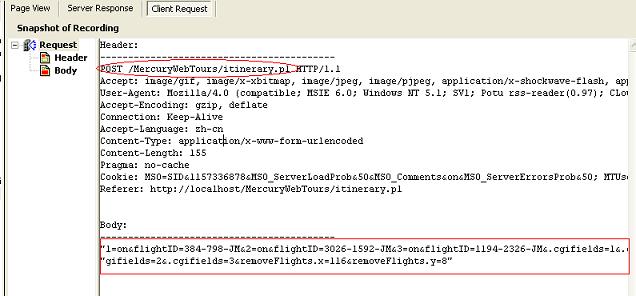转:web_custom_request应用示例
LoadRunner提供的web_custom_request函数可以用于实现参数的动态生成。在LoadRunner中,web_reg_save_param和custom_request都常于处理参数的动态生成。
web_reg_save_param函数是大家都已经熟悉的了,它的主要作用是从一个response中获得后续的request需要使用的数据,然后将其作为一个参数保存下来,供后续步骤使用。该方法在LoadRunner中被称为Correlation(关联)。
而web_custom_request函数则可以用于完全自定义向服务端发送的request。
接下来我们用一个实际的例子说明一下web_custom_request的具体应用:
以Mercury自带的MercuryWebTours例子为例,假设我们希望在登录进入后将用户的前两条记录删除,我们来看看用web_custom_request如何实现这个目标。
首先,我们尝试用HTML方式对该操作进行录制。录制后的脚本中与删除相关的部分大致如下:
 web_url("welcome.pl",
web_url("welcome.pl", "URL=http://localhost/MercuryWebTours/welcome.pl?page=itinerary",
"URL=http://localhost/MercuryWebTours/welcome.pl?page=itinerary", "Resource=0",
"Resource=0", "RecContentType=text/html",
"RecContentType=text/html", "Referer=http://localhost/MercuryWebTours/nav.pl?page=menu&in=home",
"Referer=http://localhost/MercuryWebTours/nav.pl?page=menu&in=home", "Snapshot=t3.inf",
"Snapshot=t3.inf", "Mode=HTML",
"Mode=HTML", EXTRARES,
EXTRARES, "URL=images/in_itinerary.gif", "Referer=http://localhost/MercuryWebTours/nav.pl?page=menu&in=itinerary", ENDITEM,
"URL=images/in_itinerary.gif", "Referer=http://localhost/MercuryWebTours/nav.pl?page=menu&in=itinerary", ENDITEM, "URL=images/home.gif", "Referer=http://localhost/MercuryWebTours/nav.pl?page=menu&in=itinerary", ENDITEM,
"URL=images/home.gif", "Referer=http://localhost/MercuryWebTours/nav.pl?page=menu&in=itinerary", ENDITEM, LAST);
LAST); lr_think_time(2);
lr_think_time(2);
 web_submit_form("itinerary.pl",
web_submit_form("itinerary.pl", "Snapshot=t4.inf",
"Snapshot=t4.inf", ITEMDATA,
ITEMDATA, "Name=1", "Value=on", ENDITEM,
"Name=1", "Value=on", ENDITEM, "Name=2", "Value=on", ENDITEM, "Name=removeFlights.x", "Value=116", ENDITEM,
"Name=2", "Value=on", ENDITEM, "Name=removeFlights.x", "Value=116", ENDITEM, "Name=removeFlights.y", "Value=8", ENDITEM,
"Name=removeFlights.y", "Value=8", ENDITEM, LAST);
LAST);我们通过树型模式查看一下在submit form的时候实际向服务器发出的请求的内容:
从请求内容中可以看到,我们通过POST方法发出了请求,请求发送的目的URL是/MercuryWebTours/itinerary.pl,发送的内容是:
"1=on&flightID=384-798-JM&2=on&flightID=3026-1592-JM&3=on&flightID=1194-2326-JM&.cgifields=1&.c"
"gifields=2&.cgifields=3&removeFlights.x=116&removeFlights.y=8"
从发送的内容中可以很明显的分析得出,1=on表示第一个checkbox是被选中的,flightID=384-798-JM表示的是第一条记录所对应的flightID。因此,如果我们需要自己组成这个发送的request的话,必须首先通过关联的方式获得前两条记录的flightID,然后再组成request的内容。
web_custom_request方法的原型是:
int web_custom_request (const char *RequestName, <List of Attributes>,[EXTRARES, <List of Resource Attributes>,] LAST );
其中List of Attributes的主要项目是Method,URL和BODY等。对这个例子来说,我们可以很容易构造出我们需要的request的BODY内容。
……
strcpy(creq, "Body=1=on&flightID=");
strcat(creq, lr_eval_string("{fID1}"));
strcat(creq, "&2=on&flightID=");
strcat(creq, lr_eval_string("{fID2}"));
strcat(creq, "&.cgifields=1&.cgifields=2");
strcat(creq, "&removeFlights.x=116&removeFlights.y=8");
……
其中{fID1}、{fID2}等都是通过关联获得的flightID的数据。
因此,我们可以根据图中的数据编写custom_request语句:
 web_custom_request("itinerary.pl",
web_custom_request("itinerary.pl", "Method=POST",
"Method=POST",  "URL=http://localhost/MercuryWebTours/itinerary.pl",
"URL=http://localhost/MercuryWebTours/itinerary.pl", "RecContentType=text/xml",
"RecContentType=text/xml", creq,
creq, "Snapshot=t4.inf",
"Snapshot=t4.inf", LAST);
LAST);
较为完整的代码如下:
 Action()
Action() {
{ char creq[500];
char creq[500];
 web_reg_save_param("fID1", "LB=INPUT TYPE=\"hidden\" NAME=\"flightID\" VALUE=\"", "RB=\"", "ORD=1",
web_reg_save_param("fID1", "LB=INPUT TYPE=\"hidden\" NAME=\"flightID\" VALUE=\"", "RB=\"", "ORD=1",  "SEARCH=BODY", LAST);
"SEARCH=BODY", LAST); web_reg_save_param("fID2", "LB=INPUT TYPE=\"hidden\" NAME=\"flightID\" VALUE=\"", "RB=\"", "ORD=2",
web_reg_save_param("fID2", "LB=INPUT TYPE=\"hidden\" NAME=\"flightID\" VALUE=\"", "RB=\"", "ORD=2",  "SEARCH=BODY", LAST);
"SEARCH=BODY", LAST); web_url("welcome.pl",
web_url("welcome.pl", "URL=http://localhost/MercuryWebTours/welcome.pl?page=itinerary",
"URL=http://localhost/MercuryWebTours/welcome.pl?page=itinerary", "Resource=0",
"Resource=0", "RecContentType=text/html",
"RecContentType=text/html", "Referer=http://localhost/MercuryWebTours/nav.pl?page=menu&in=home",
"Referer=http://localhost/MercuryWebTours/nav.pl?page=menu&in=home", "Snapshot=t3.inf",
"Snapshot=t3.inf", "Mode=HTML",
"Mode=HTML", EXTRARES,
EXTRARES, "URL=images/in_itinerary.gif", "Referer=http://localhost/MercuryWebTours/nav.pl?page=menu&in=itinerary", ENDITEM,
"URL=images/in_itinerary.gif", "Referer=http://localhost/MercuryWebTours/nav.pl?page=menu&in=itinerary", ENDITEM, "URL=images/home.gif", "Referer=http://localhost/MercuryWebTours/nav.pl?page=menu&in=itinerary", ENDITEM,
"URL=images/home.gif", "Referer=http://localhost/MercuryWebTours/nav.pl?page=menu&in=itinerary", ENDITEM, LAST);
LAST); lr_think_time(2);
lr_think_time(2);
 strcpy(creq, "Body=1=on&flightID=");
strcpy(creq, "Body=1=on&flightID="); strcat(creq, lr_eval_string("{fID1}"));
strcat(creq, lr_eval_string("{fID1}")); strcat(creq, "&2=on&flightID=");
strcat(creq, "&2=on&flightID="); strcat(creq, lr_eval_string("{fID2}"));
strcat(creq, lr_eval_string("{fID2}")); strcat(creq, "&.cgifields=1&.cgifields=2");
strcat(creq, "&.cgifields=1&.cgifields=2"); strcat(creq, "&removeFlights.x=116&removeFlights.y=8");
strcat(creq, "&removeFlights.x=116&removeFlights.y=8");
 lr_output_message(creq);
lr_output_message(creq);
 web_custom_request("itinerary.pl",
web_custom_request("itinerary.pl", "Method=POST",
"Method=POST",  "URL=http://localhost/MercuryWebTours/itinerary.pl",
"URL=http://localhost/MercuryWebTours/itinerary.pl", "RecContentType=text/xml",
"RecContentType=text/xml", creq,
creq, "Snapshot=t4.inf",
"Snapshot=t4.inf", LAST);
LAST);
 return 0;
return 0; }
}



